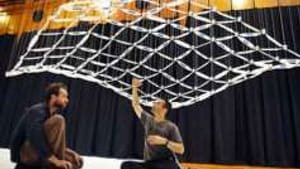Stay in the Loop
BSR publishes on a weekly schedule, with an email newsletter every Wednesday and Thursday morning. There’s no paywall, and subscribing is always free.
Is it movement, or just twitching?
Chunky Move's "Connected' at Annenberg

The American sculptor Reuben Margolin and the Australian director/choreographer Gideon Obarzanek are two men with a similar fascination with movement in space, and with the connection between abstract forms and concrete objects.
Margolin creates kinetic installations: flexible forms of new and recycled metal, plastic and crystals linked with pulleys and animated with motors. (To view videos of his work, click here.) Obarzanek, who founded the dance company Chunky Move, has developed several works utilizing motion tracking and projection technology.
When the two men met in 2009, their conversations led to Connected, a collaboration presented last week as the first offering in the Annenberg Center's Dance Celebration season.
The audience enters the theater to find an array of dangling wires weighted with balls at the right rear of the stage. These wires are gathered at the top of that arrangement and strung over to a device that resembles a spinning wheel on the left side of the stage.
Sculpture unhooked
During the first third of the performance, some of the five dancers moved about frenetically to cacophonous music while others connected the balls to each other to complete the sculpture, a flexible plane that evokes a wing, a blanket, and the rolling sea. During the second third, the wires were unhooked from the spinning wheel and hooked onto four of the dancers, who controlled the undulations of the sculptural plane with their own movements.
In the final third, the sculpture was hooked back to the wheel, which was then set in motion to a spoken-word piece based on interviews with art gallery guards as the dancers moved around, under, and in front of the sculpture.
The "connections" of the piece refer to physical connections, of course: the connections by which the dancers move both the sculpture and each other. The word also refers to other, more subtle connections: between artistic genres, for one, and between art and viewer (performers and audience; artworks and guards) for another.
Confusing the audience
This last connection raised the most issues for me. For Obarzanek, the construction of the sculpture during the first section is important for the piece's overall meaning. But the audience is left distracted and confused by the actions of the dancers fiddling with the sculpture. Are we supposed to watch them? Or are we supposed to watch the dancers who are, well, dancing? If the latter, why aren't their movements more interesting?
In the second section, when the dancers control the sculpture, they do so with such restraint that it's not at all clear what dancer movement on the left is causing what tilting or shifting of the sculpture's movement on the right.
In a post-performance Q&A session, Obawrzanek said that in the development of the piece the troupe had experimented with other, more "virtuosic" moves, but that he had decided against including them in the performance. Bad call— it wouldn't have been pandering to the audience's thirst for spectacle to do something more interesting than the subtle twitches that they ended up with.
Overall, the collaboration can be chalked up as an interesting experiment. But the ultimate execution felt like a series of missed opportunities.
Margolin creates kinetic installations: flexible forms of new and recycled metal, plastic and crystals linked with pulleys and animated with motors. (To view videos of his work, click here.) Obarzanek, who founded the dance company Chunky Move, has developed several works utilizing motion tracking and projection technology.
When the two men met in 2009, their conversations led to Connected, a collaboration presented last week as the first offering in the Annenberg Center's Dance Celebration season.
The audience enters the theater to find an array of dangling wires weighted with balls at the right rear of the stage. These wires are gathered at the top of that arrangement and strung over to a device that resembles a spinning wheel on the left side of the stage.
Sculpture unhooked
During the first third of the performance, some of the five dancers moved about frenetically to cacophonous music while others connected the balls to each other to complete the sculpture, a flexible plane that evokes a wing, a blanket, and the rolling sea. During the second third, the wires were unhooked from the spinning wheel and hooked onto four of the dancers, who controlled the undulations of the sculptural plane with their own movements.
In the final third, the sculpture was hooked back to the wheel, which was then set in motion to a spoken-word piece based on interviews with art gallery guards as the dancers moved around, under, and in front of the sculpture.
The "connections" of the piece refer to physical connections, of course: the connections by which the dancers move both the sculpture and each other. The word also refers to other, more subtle connections: between artistic genres, for one, and between art and viewer (performers and audience; artworks and guards) for another.
Confusing the audience
This last connection raised the most issues for me. For Obarzanek, the construction of the sculpture during the first section is important for the piece's overall meaning. But the audience is left distracted and confused by the actions of the dancers fiddling with the sculpture. Are we supposed to watch them? Or are we supposed to watch the dancers who are, well, dancing? If the latter, why aren't their movements more interesting?
In the second section, when the dancers control the sculpture, they do so with such restraint that it's not at all clear what dancer movement on the left is causing what tilting or shifting of the sculpture's movement on the right.
In a post-performance Q&A session, Obawrzanek said that in the development of the piece the troupe had experimented with other, more "virtuosic" moves, but that he had decided against including them in the performance. Bad call— it wouldn't have been pandering to the audience's thirst for spectacle to do something more interesting than the subtle twitches that they ended up with.
Overall, the collaboration can be chalked up as an interesting experiment. But the ultimate execution felt like a series of missed opportunities.
What, When, Where
Chunky Move: Connected. November 17-19, 2011 at Zellerbach Theater, Annenberg Center, 3680 Walnut St. (215) 898-3900 or www.AnnenbergCenter.org.
Sign up for our newsletter
All of the week's new articles, all in one place. Sign up for the free weekly BSR newsletters, and don't miss a conversation.

 Judy Weightman
Judy Weightman